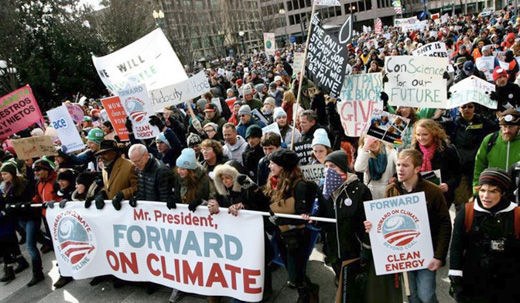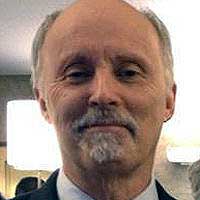
NEW YORK — “We have 80 days until September 21… Are you down? Are you ready to build the largest climate march in history?”
That was the question Eddie Bautista, representing the People’s Climate March Host Committee, asked the audience at a recent planning meeting for the national People’s Climate March scheduled for Sept. 21 here at UN headquarters.
The crowd of some 450 in a packed meeting room answered with a resounding “Yes!”
“What do we want? Bautista continued. “Climate action!” the audience shouted back. “When do we want it? Now!!!”
The march has been endorsed by over 325 organizations, including many international and national unions, churches, schools and community and environmental justice organizations.
The march has been timed to take place in conjunction with the United Nations climate summit of world leaders. The summit has been called by UN Secretary General Ban Ki-moon because UN-backed negotiations to finalize a climate change agreement have been stalled. The U.S. government, backed by powerful fossil fuel companies, has thrown up many of the roadblocks to progress.
This spring the UN’s Intergovernmental Panel on Climate Change reported a significantly narrower window of opportunity to undertake fundamental change before the environmental crisis spins out of control. Climate change is real, caused by human activity, and coordinated international public policy is needed if planet earth is to avoid a cycle of famines, floods, droughts, rising temperatures, and deepening wars over resources, the report said.
Some in the audience were veterans of past actions, like the 50,000-strong rally last year organized by 350.org in Washington DC against the Tar Sands XL Pipeline, or local anti-fracking battles in the tri-state area. Representatives of unions, churches, schools and community organizations, many new to the climate action movement, came for tools they can use to mobilize their members in the coming weeks.
Many high school and college students were in attendance, identifying the struggle for climate action as a cutting edge battle of their generation. Parents came to learn how to fight for a future for their children and grandchildren.
They all responded enthusiastically to the call for a giant united national mobilization at the UN — with a strong message to world political leaders, corporate executives, climate change deniers and obstructionists of all stripes, that climate action is demanded now.
“With our future on the line, and the whole world watching, we will take a stand to bend the course of history,” the call for the demonstration reads. “The People’s Climate March demands the world we know is within our reach: a world with an economy that works for people and the planet; a world safe from the ravages of climate change; a world with good jobs, clean air and water, and healthy communities.”
In addition to the march’s official demands, it is expected participating organizations will bring some of their own, linking the need for climate action to other environmental issues like opposition to fracking, the Tar Sands XL Pipeline, an end to environmental racism, retraining of displaced workers for a program of new good green jobs, and more.
A theme at the planning meeting was the need to mobilize a broad and diverse turnout, in order that the demonstration’s message is difficult to ignore. “Think bolder, think bigger, think more creatively,” said Leslie Cagan, the March’s national organizer, to the audience.
A particular priority at the meeting was the necessity of outreach to labor and communities of color, sectors that big business especially has sought to divide from the environmental movement. Discussed was big business’ demagogic counterposing of jobs to climate action, and its use of racism.
” I come to you with a message from 1199, representing 400,000 workers,” said Estela Vasquez, senior vice president of Local 1199, SEIU Healthcare Workers East. “The message is for those who have tried to separate organized labor from the environmental justice movement. The environmental issue is a workers issue.
“The message we want to bring is that questions of climate change, the impact of corporations, are workers’ concerns. They can no longer separate us and say because of workers needs and jobs that we have no interest in what is happening to us. “
Tammy Shapiro, a representative of Rockaway Wildfire, spoke of how climate change disproportionately affects people of color in New York, whether through the location of coal- fired plants in the South Bronx, or the impact of Hurricane Sandy in Far Rockaway, Coney Island, and Red Hook. In an appeal to the environmental movement, she called for a special outreach to people of color, given the existence of “environmental racism.”
Vasquez also spoke about how rising sea levels due to global warming have already affected Caribbean shorelines and islands, where many of her union members have family ties, and called for building a strong “labor-community coalition” around the issue.
Climate change is real and here to stay, said Reverend Clinton Miller of Brown Memorial Baptist Church in Brooklyn, New York. He stated that his church, like many in New York City, has helped provide resources for the victims of Hurricane Sandy, but should also be fighting for solutions to the environmental crisis.
In an appeal to the faith-based community, he called climate change “the overriding issue of our time”, which determines “how we live, where we live, and if we live,” and urged others in the faith-based community to take a stand, if “my religion to be more relevant. “
Leslie Cagan, National March Coordinator, updated the audience about march preparations, including the opening of the mobilization’s headquarters in midtown Manhattan and the establishment of a website at peoplesclimate.org/march. National and international demonstrations are planned to accompany the march in New York City on that day.
Larry Moskowitz, labor coordinator for the march, emphasized at the labor breakout session the importance of including the demand for good green Jobs, if a successful mobilization for climate action is to be realized.
Among the unions endorsing the march so far are IBEW Local 3, TWU Local 100, DC 37, 32BJ SEIU, Teamsters District 16, United Auto Workers District 9A and the New York State Nurses Association.
Activists in the labor, faith-based and youth and student breakout sessions mapped plans to approach unions and community organizations that had not yet endorsed, and discussed how to help mobilize a grass- roots turnout. Attendees committed to spreading the word among friends, neighbors, co-workers, and through their social media networks in the 80 days remaining.
“Mark your calendars for September 21, said Bill McKibben, in a widely read article about the march in a recent issue of Rolling Stone.” It will be a day to tell your grandchildren – if we are successful.”
Leslie Cagan put it another way. ” We are the right thing, at the right time, in the right place. And we are the people to make it happen.”
“Whatever you are thinking about doing to build this mobilization – rethink it. Make it bigger, make it bolder, make it more creative. Make it more challenging to your friends, your coworkers, to your neighbors…. because literally the whole world will be watching. “
Photo: On February 17th, 50,000 people came together on the National Mall to tell President Obama to move forward on climate and reject Keystone XL. 350.org Facebook page.








